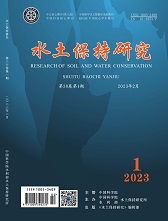[1]CHAI Cheng-wu,HE Fang-yin,WEI Lin-yuan,et al.The Study on Vegetation Restoration Model of Saline Abandoned Farmland in Arid Sandy Regions[J].Research of Soil and Water Conservation,2011,18(06):208-211,215.
Copy
The Study on Vegetation Restoration Model of Saline Abandoned Farmland in Arid Sandy Regions
Research of Soil and Water Conservation[ISSN 1005-3409/CN 61-1272/P] Volume:
18
Number of periods:
2011 06
Page number:
208-211,215
Column:
Public date:
2011-12-20
- Title:
- The Study on Vegetation Restoration Model of Saline Abandoned Farmland in Arid Sandy Regions
- CLC:
- X171.1
- DOI:
- -
- Abstract:
- Some natural recovery objectives were set up and 10 modes of saline vegetation restoration were put forward based on vegetation survey in different years on abandoned farmland in Minqin lake regions. Six better ecological restoration models were selected by the evaluation of the relevant indicators of the model vegetation which performed in three years. SEFM and LEFM are near-natural vegetation recovery mode, but this model based on some irrigation measures in the initial three years will be near-natural recovery at the later stage. TGPM and TMPM are the purely artificial recovery models which are good for increasing the plant density in the initial planting, thinning plants at the later stage to reduce the ecological pressure. TLPM and TLPM are the best models in terms of low cost and high eco-efficiency.
- References:
-
[1] 马长明, 袁玉欣.国内外退耕地植被恢复研究现状[J].世界林业研究, 2004, 17(4):24-27.
[2] 王堃, 吕进英.退耕地的自然演替与人工恢复[J].中国农业资源与区划, 2000, 21(4):51-55.
[3] 黄从德, 张健, 邓玉林, 等.退耕还林地在植被恢复初期碳储量及分配格局研究[J].水土保持学报, 2007, 21(4):130-133.
[4] 李艳, 李鹏, 赵忠.退耕地植被恢复演替的生态环境效应研究进展[J].西北农林科技大学学报:自然科学版, 2007, 35(8):155-159.
[5] 焦峰, 温仲明, 焦菊英.黄土丘陵区退耕地土壤养分变异特征[J].植物营养与肥料学报, 2005, 11(6):724-730.
[6] 陈小红, 张健, 赵安玖.短期型林(竹)-草复合植被还林初期土壤碳氮动态变化[J].水土保持学报, 2008, 22(2):126-130.
[7] 胡建忠, 郑佳丽, 沈晶玉.退耕地人工植物群落根系生态位及其分布特征[J].生态学报, 2005, 25(3):481-490.
[8] 杨正礼.我国西北地区退耕地植被恢复基本途径与模式探讨[J].中国人口·资源与环境, 2004, 14(5):36-41.
[9] 王俊明, 张兴昌.退耕草地演替过程中的碳储量变化[J].草业学报, 2009, 18(1):1-8.
[10] 李世东, 吴转颖.中西部地区退耕还林还草模式探讨[J].林业科学, 2002, 38(3):154-159.
[11] 谌红辉, 方升佐, 丁贵杰, 等.马尾松人工同龄纯林自然稀疏规律研究[J].林业科学研究, 2010, 23(1):13-17.
[12] 王宁, 贾燕锋, 焦菊英, 等.陕北安塞退耕地持久土壤种子库与地上植被的对应关系[J].中国水土保持科学, 2009, 7(6):51-57.
[13] 王继和, 马全林, 刘虎俊, 等.干旱区沙漠化土地逆转植被的防风固沙效益研究[J].中国沙漠, 2006, 26(6):903-909.
[14] 蒋德明, 宗文君, 李雪华.科尔沁西部地区荒漠化土地植被恢复技术研究[J].生态学杂志, 2006, 25(3):244-248.
[15] 玉宝, 王百田, 乌吉斯古楞.干旱半干旱区人工林密度调控技术研究现状及趋势[J].林业科学研究, 2010, 23(3):472-477.
[16] 陈刚, 孙国荣, 彭永臻, 等.星星草(Puccinellia tenuiflora)人工草地氮素积累对松嫩盐碱草地植被演替的影响[J].生态学报, 2008, 28(5):2031-2041.
[17] 朱虹, 祖元刚, 王文杰, 等.盐碱地的植被恢复与盐碱地改良方法的评述[J].吉林林业科技, 2007, 36(5):14-21.
[18] 张丽珍, 牛伟, 牛宇, 等.柠条对盐碱地植被组成及土壤特性的影响[J].生态学报, 2009, 29(9):4693-4699.
- Similar References:
Memo
-
Last Update:
1900-01-01
